1/48 Airfix Spitfire II
The first upgrade of the Spitfire was the Spitfire II, developed to take advantage of a more powerful version of the Marlin engine.
Spitfire Mk.I K9788 was fitted with a Merlin XII in the summer of 1939. Tests demonstrated improved performance and it was ordered that this Spitfire, designated Spitfire II and known to Supermarine as the Type 329, would be the first version to be produced exclusively by the huge new Nuffield Group shadow factory at Castle Bromwich. A total of 921 Mk IIs were built, all by Castle Bromwich.
The Merlin XII provided 1,175 horsepower and included a Coffman starter enclosed in a teardrop fairing on the forward starboard cowling, rather than the electric system used on the Spitfire I. The Merlin XII was cooled by a 70/30 water-glycol mix instead of pure glycol.
Following a successful test of Spitfire Is of 54 and 66 squadrons fitted with a new Rotol-manufactgured wide-blad prop recognizeable by a larger, more rounded spinner, which demonstrated better performance than the deHavilland two-position prop, it was ordered that the new propeller would also be used exclusively by the Mk II. This engine/propeller combination increased top speed over the deHavilland-equipped late Mk I by about 6 7 mph below 17,000 feet, and improved climb rate. Due to weight increases maximum speed was lower than early Mk Is, but combat capability in terms of climb rate and overall speed retention in maneuvers was far better. Deliveries commenced in the fall of 1940 and by April 1941 the Spitfire II had replaced all Mk. Is in first-line service. The Rotol propellers were supplemented by de Havilland constant speed units similar to those fitted to Mk. Is.
On 18 March 1941, Douglas Bader became one of the first "wing leaders" as RAF Fighter Command commenced its “Lean into France” that Spring. Bader's wing was based at Tangmere with 145, 610 and 616 Squadrons under his command. He actively led his wing on sweeps and "Circus" operations (medium bomber escort) over north western Europe throughout the summer campaign. These missions combined a few bombers with massive fighter escorts and were intended to lure out and tie down Luftwaffe fighter units which might otherwise serve on other fronts.
In late May 1941, Bader worked a private deal with the Castle Bromwich factory to bring his wing's Spitfire IIs over a few at a time to have their fabric-covered ailerons replaced with metal ailerons developed for the Spitfire V. This modification vastly improved maneuverability, but during the time of transition (May-June) it caused problems when the flight leaders had metal ailerons while the wingmen didn't. “I say, Dogsbody, we haven't all got bloody metal ailerons” was a common complaint as the pilots worked to keep up with their leader.
This was called “The Non-stop Offensive” by the RAF for publicity purposes and “The Nonsense Offensive” by the Luftwaffe. Sadly, the Luftwaffe's term was more accurate. The Germans could pick their time to attack or not, while the RAF fighters were tied down to close escort of a force of 4-6 Blenheims with their pilots closely watching their gas gauges. The RAF was unable to penetrate past the coastal belt of airfields and only had some 10 minutes' combat time available to each of the three wings - “penetration,” “target” and “return” - that made the mission. The Blenheims only carried 1,000 pound bomb load, and were easy to shoot down, while the damage they did was quickly repaired. Adolf Galland's favorite tactic was to use the Bf-109's altitude advantage to dive through the escorts and knock down a Blenheim, continuing his dive away from the British formation before the defending fighters could get organized. A few missions were flown with the new Stirling I four-engine bombers acting as “bait,” but they turned out to be almost as vulnerable as the Blenheims and were quickly put back on night operations only.
Additionally, the Luftwaffe re-equipped the Channel Geschwadern with the Bf-109F-2, which outperformed the Spitfire II, and which the Spitfire V that was on its heels in re-equipping RAF squadrons was hard-pressed to keep up with. The Germans only needed JG 2 and JG 26 in France and JG 1 in Holland to defend the Channel coast.
Bader scored frequently during the offensive sweeps. On 7 May 1941 he shot down one Bf-109E and claimed another as a probable victory; the German formation was led by Adolf Galland, who scored his 68th victory against Bader's wing. On 21 June, Bader shot down a Bf-109E off the coast near Desvres. On 25 June he shot down two Bf-109Fs - the first one and a damaged Bf-109F on the morning mission and the second on the afternoon mission. July was particularly successful for Bader, who was awarded a bar to his DSO on 2 July. That afternoon, he claimed one Bf-109 destroyed and another damaged. On 4 July, he nearly collided with a Bf-109 that slowed fast after he hit it, probably killing the pilot, though it was claimed “probable” since no one witnessed a crash. On 6 July he shot down a Bf-109 whose pilot bailed out; the victory was witnessed by his wingman, Pilot Officers J.E. “Johnny” Johnson. On 9 July, he claimed one probable and one damaged, both trailing coolant or oil. On 10 July he shot down a Bf-109 and one damaged over Bethune. On a mission later that day he destroyed a Bf-109E that blew up over Calais. On 12 July, he shot down one Bf-109 and damaged three others between Bethune and St. Omer. On 23 July, he claimed another Bf-109 possibly destroyed, even though the action resulted in two Bf-109s destroyed with the other was shot down by 616's Squadron Leader Burton. Bader did not see his Bf 109 crash, so claimed it “probable” despite the fact pilots of 242 Squadron saw two 109s crash. The following week he converted on to his last Spitfire, a Mk. Va.
As the Spitfire V became available beginning in late April 1941, the Spitfire IIs were passed down to squadrons that had been flying the thoroughly-outclassed Hurricane, such as 71 Eagle Squadron, which finally received Spitfires in late July. By the summer of 1941, most RAF Fighter Command Squadrons in 11 Group had re-equipped with the Spitfire V, with the last Spitfire IIs leaving the front line units in September.
Airfix released an entirely new Spitfire I kit in 2015, that is the most accurate Spitfire I available in 1/48 scale. The kit also includes the necessary Coffman starter fairing and the Rotol propeller, and the later pitot tube, which means Airfix will at some point release the kit as a Mk.II. Modelers, however, need not wait for this release. There is at least one aftermarket decal sheet with a Spitfire II on it, that being the Victory Productions Decals “Spitfire: Aces of the Empire” sheet which has been in continuous production since 2002, since it is the best and most comprehensive sheet out there for Spitfire fanatics. The airplane on the sheet is the Spitfire II “Manxman,” P7966, flown by Douglas Bader in 1941.
The only variation from constructing the Mk.I is to open the hole in the forward starboard cowling and attach the Coffman fairing, to use the Rotol Prop, and the later pitot tube.
One can also modify the separate ailerons to be “metal covered” by sanding off the raised detail and scribing in the detail associated with metal ailerons, to reproduce “Manxman” as she looked in the summer of 1941.
If you don't use the Coffman starter fairing, and replace the early oil cooler with the later oil cooler that is on the sprues, you can make a Spitfire Va should you so desire. The only well-known Spitfire Va would be that flown by Bader, and if you can source W3185 letters and numbers, you can do his last Spitfire since it used the same “D-B” codes and had the “kicking Hitler” marking that is used on the Mk.II. This would have been a “factory-fresh” airplane in terms of paint and markings.
The model was painted freehand with Tamiya Dark Earth (a mixture of Flat Earth and Khaki), Dark Green (from the RAF colors paints) and Sky. If you can't tighten your airbrush down to get a tight edge, I recommend you make masks, and run thread around the edges so you can do “scale overspray.”
I used the Spitfire Aces of the Empire decals for the national insignia and personal markings, and the kit decals for the stenciling.
I applied moderate exhaust and gunfire staining, unmasked the canopy and fitted it in the open position, attached the side flap, landing gear and prop.
The Airfix Spitfire I kit is the best early Spitfire kit in 1/48. Other than a bit of difficulty with the gear legs that is easily dealt with, the kit presents no problems and looks good when finished. Highly recommended to Spitfire fans.
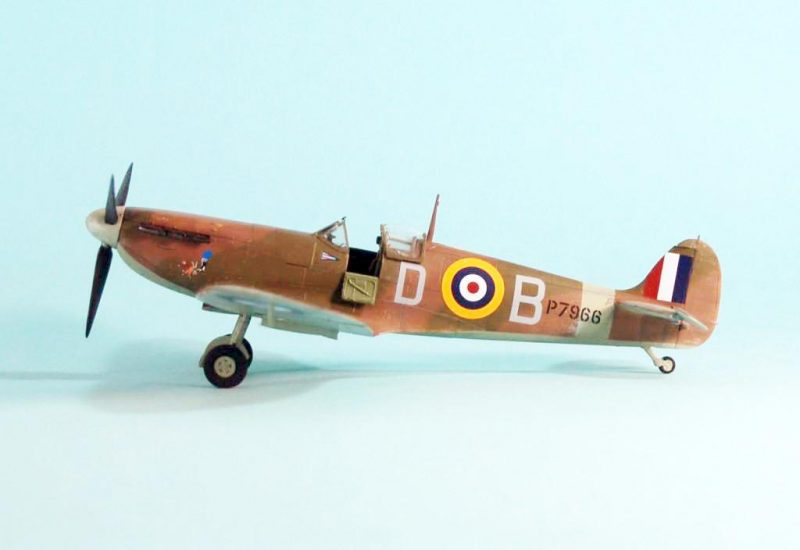
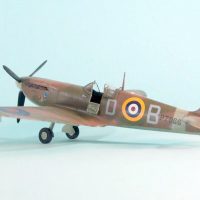
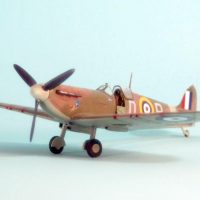
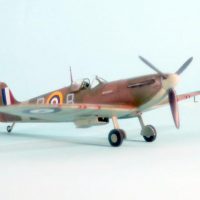
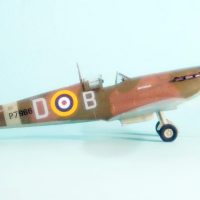
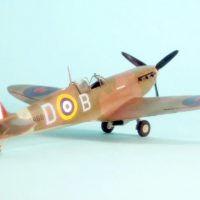
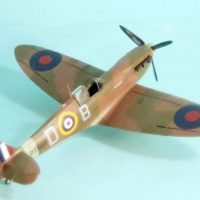
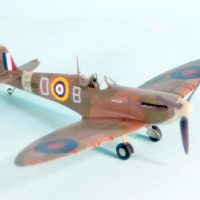
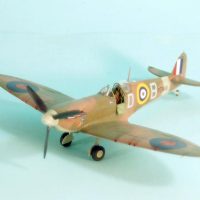
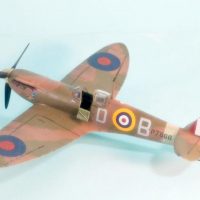
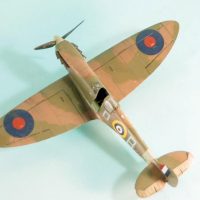
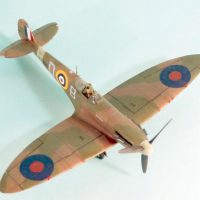
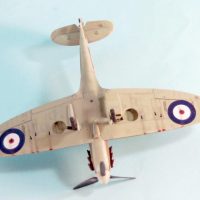
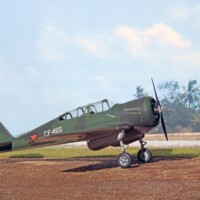
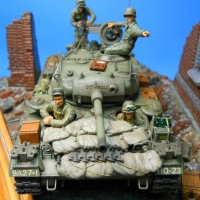
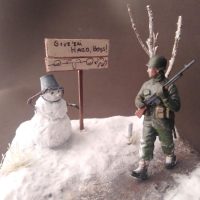
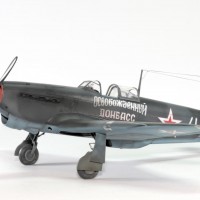
Nice build and history
Nice one Tom. Thanks also for the background details. Always interesting.
Great build !
Good lookin' build/pics/story.
Awesome build and a great story to boot ! Thanks for sharing.
This reminds me of the Spitfires in the Battler Britain comic books I used to read when I was a kid, so it must be authentic!
Great build of the best looking marque, in my opinion.
Nice job Tom, looks good. Always enjoy reading your articles
Nice as always Tom!
Excellent as usual.
Great Spitfire ! nice work